BANGLADESH
History

History

History
Antiquity
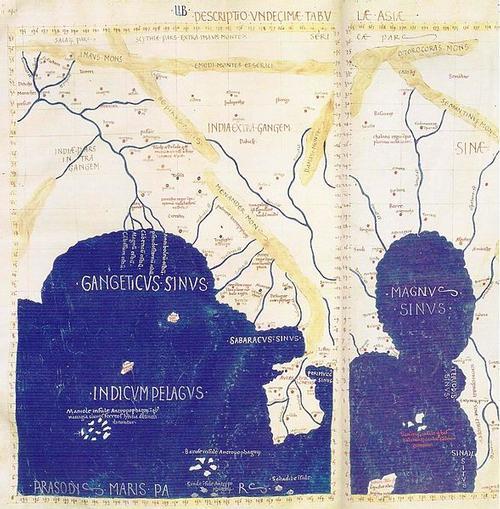
Not much is known about the oldest history of Bangladesh. Well-known groups of residents such as the Kol, the Polinda and the Hadi spoke a language very similar to the Dravidian languages of South India. The current inhabitants of the Chittagong Hill Tracts are related to the later invaded Tibeto-Burman tribes.
From 1400 BC. Indo-German Aryans invaded southern Asia from Afghanistan. Although these Aryans never reached what was then Bengal, which comprised present-day Bangladesh and the Indian state of West Bengal, their influence on Bangladeshi society was enormous.
They introduced Hinduism, and with it the caste system. In this caste system the highest caste, that of the brahmins, got all the ground in hands. After that came the warriors or "kayasthas", and the peasants ended up in the lower castes or even became casteless. The social inequality thus created caused Buddhism from the 5th century BC. got many followers. From that time on, Hindu and Buddhist rulers alternated.
Islam, Portuguese and Dutch
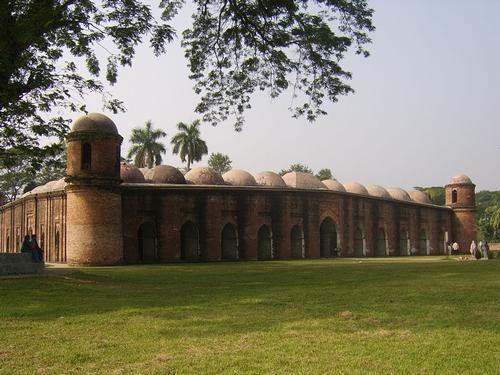
In a later period, Islam took a lot of influence on Bangladeshi society, also as a reaction to the strict caste system. Muslim rulers ruled the Indian subcontinent for centuries and many Muslim merchants settled along the coasts of South Asia. In addition, Muslim farmers settled in Bengal because of the fertile soil.
Important for the spread of Islam were of course the Islamic religious teachers, who founded mosques and Koran schools. Islamic communities arose around these schools and mosques and Delhi, the current capital, was, for example, an Islamic sultanate. In the 14th century, Bengal broke away from Delhi and one of the capitals in the new area became Dhaka, the current capital of Bangladesh.
In the early 16th century, the Muslim Mogul king Baber of Kabul founded the empire of the Great Moguls from North India with Delhi as its capital. In 1576 Akbar conquered the Greater Bengal and used the conquered territory mainly as a colony.
At the same time, the Portuguese appeared off the coasts of Bengal, followed not long after by the ships of the Dutch Vereenigde Oost-Indische Compagnie. Because the Dutch, unlike the Portuguese, only came to trade, they were soon able to found their own fortress and office. In 1690 the British East India Company established itself in Calcutta and that would later have major consequences for the Indian subcontinent. In the early 18th century, the Mogul Empire, under Aurangzeb, was at its peak, encompassing Pakistan and most of India in addition to present-day Bangladesh. Islam was the largest religion in Bengal at the time.
Bengal part of British India
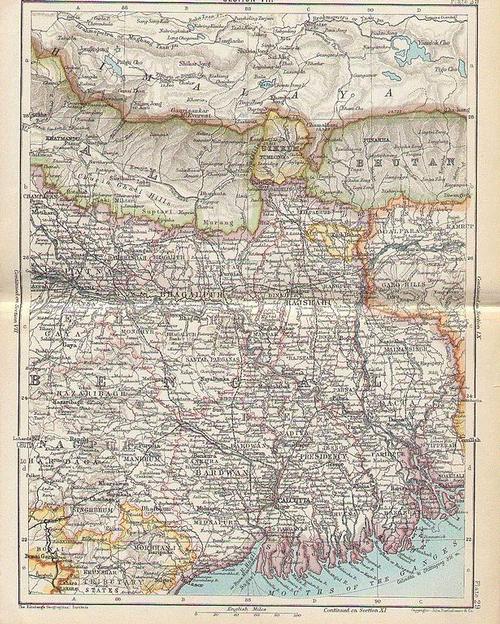 Map of Bengal under British rule around 1893Photo: Public domain
Map of Bengal under British rule around 1893Photo: Public domain
Around 1750 the Mogul Empire fell into disrepair and from that time the British dominated the history of Bengal. French and Dutch were expelled and everywhere they founded trading bases and political-military bases. After a failed revolt by Mogul governor Siraj-ud-Daulad in 1757, the British gradually conquered all of Bengal and made great profits from exports of cotton and silk products. In 1770, after a crop failure, a famine broke out that killed two-thirds of the Bengal population. In addition, tens of thousands of textile workers were put out of work due to the emergence of mechanized textile production in Britain. As a result, a prosperous city like Dhaka went into total disrepair and hundreds of thousands of inhabitants left the city for the countryside.
But the Bengals also had a hard time in the countryside. Land tax was often forcibly collected by wealthy Hindus ("zamindars"), who were appointed by the British. The Permament Settlement Act, passed in 1793, even deprived the farmers of their age-old fundamental rights, and the imposed usurious interest caused a great deal of misery and poverty. In addition, many farmers were obliged to cultivate indigo plants, which yielded the indigo dye much loved in Great Britain. As a result, the land area for the cultivation of rice and other food crops decreased, the prices of those products rose and poverty increased even further.
Eventually, the farmers stopped taking it and an armed protest ensued in which tens of thousands of farmers in a number of districts took part. However, massive protests against the British did not materialize. In 1860 the British government abolished the compulsory indigo overhang. The zamindar system described above was not abolished until 1950, after independence.
British India is divided into Pakistan and India
In the second half of the nineteenth century, more and more nationalist sentiments arose in South Asia. In 1885 this led to the establishment of the Indian Congress Party, which consists mainly of Hindus. However, in East Bengal (present-day Bangladesh), 60% of the population was Muslim. They felt oppressed by the British and the wealthy Hindus. In response, important Muslims from across British India founded the All India Muslim League. Unlike the Indian National Congress Party, the Muslim counterpart was pursuing a division of British India into an Islamic and a Hindu part. The condition was that every province where Muslims were in the majority would be part of the new state to be formed.
On August 15, 1947 the time had come. British India was divided into the two independent states of Pakistan and India, with Pakistan divided into West and East Pakistan with 1,500 km of Indian territory in between. Immediately a true migration of people started: about eight million Hindus moved to India, and just as many Muslims left India for Pakistan. Hundreds of thousands were killed during religious riots, especially in the Punjab region.
In Bengal, the divorce was much more relaxed when the province was divided into an eastern Muslim part and a western Hindu part. Muslim Sylhet in the northern province of Assam joined East Pakistan, and many Muslims from the Indian state of Bihar also moved there. It was remarkable that Hindu villages in Muslim East Bengal completely swapped places of residence with Muslim villages in West Bengal.
Although more people lived in East Pakistan than in West Pakistan, the East Pakistanis were poorly represented in senior administrative and military positions. Furthermore, foreign aid mainly went to West Pakistan and the government made Urdu the official language. The latter, in particular, fell very badly with the East Pakistanis, and student riots broke out in Dhaka and other cities known as the "Language Movement". From this movement emerged a new non-religious nationalism, which expressed its political aspirations in the creation of the Awami League in 1949. This party, led by Sheikh Mujibur Rahman since 1953, pursued regional autonomy. In 1956 they gained momentum when Bengali became the national language in East Pakistan.
Bangladesh independant
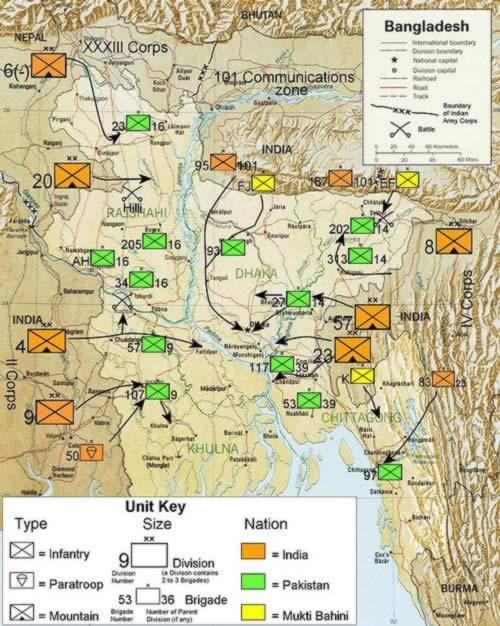
Due to the ongoing hostilities between India and Pakistan due to the grant of largely Muslim Kashmir to India in 1947. This struggle weakened Pakistan to such an extent that they no longer interfered so much with East Pakistan. In December 1970, the AL won the elections in Pakistan and became by far the largest party with 288 of the 300 seats. The then military ruler Yahya Kahn, however, delayed the formation of a government and this resulted in an explosive situation in East Pakistan. On March 25, 1971, the Pakistan army launched "Operation Bengal". Tanks and soldiers carried out a massacre at Dhaka University, killing hundreds of police. Mujibur Rahman was arrested, but Bangladesh's independence was declared on April 17, 1971. The fighting continued, however, and eventually one million people died and about 5 million people fled to India.
Only the remaining Muslims still supported the government of Pakistan, although some major progressive groups certainly did not support Mujibur Rahman and the AL. These groups fought for land redistribution in favor of peasants, something that worried Indian Prime Minister Indira Gandhi. As the progressive forces grew stronger, India intervened. Indian troops moved into Eastern Pakistan and India recognized Bangladesh's independence under the Awami League. The battle between the Indian and Pakistani armies lasted only two weeks, but the progressive freedom fighters were also defeated because their plans for the peasants were abandoned. For the second time many Hindus returned to India.
Bangladesh under military rulers
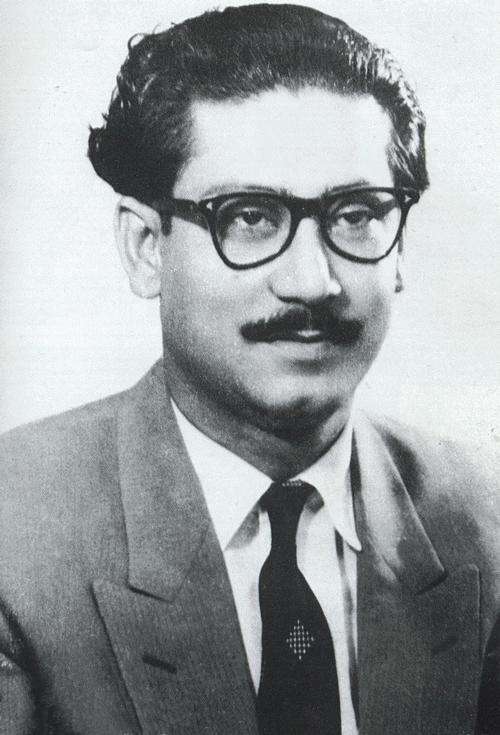
Mujibur Rahman BangladeshPhoto: Public domain
In January 1972, Mujibur Rahman returned from Pakistani captivity to Bangladesh and formed a government with the initial support of the poor peasant population. In 1973 the AL won another major electoral victory, but after that the reign of Mujibur Rahman was quickly over. There was a lot of corruption, many companies were nationalized and thousands of political opponents were murdered. On top of that was the great famine of August 1974, in which food aid did not reach the poor population but largely to the rich. Bangladesh was recognized by Pakistan in 1974.
At the end of 1974, Mujibur Rahman declared a state of emergency, suspended the constitution and banned all political parties except the AL. Dissatisfaction with this policy grew rapidly and it was therefore not surprising that Mujibur Rahman and his family were murdered in August 1975 by some young army officers.
That same year, two more military coups were to follow, the last of which was committed by General Zia-ur Rahman, who became president in December 1977. In January 1978, the people of Bangladesh voted in a referendum in favor of Zia remaining as president. He restored the multiparty system, and with the help of conservative Islamic politicians, Islam became the state religion in 1978. The elections in June of that year were a major victory for the Bangladesh National Party (BNP) founded by Zia. Zia's reign was notable for a foreign policy that focused on both the Western and Arab world. The domestic politician was notable for many development projects in the countryside and a separate administration for each village.
However, Zia-ur Rahman was also murdered in 1981. Justice Abbess Sattar became acting president, but after a few months already pushed aside by General Hossain Ershad, who appointed himself president at the end of 1983 and was in fact sole ruler.
Ershad also founded his own party, the Patiya Party (JP), the national party. This party won several elections, but this was always accompanied by electoral fraud and division between political opponents. To counter this, the AL, led by Mujibur Rahman's daughter, Sheikh Hasina, and the BNP, led by Zia-ur Rahman's daughter, Khaleda Zia, entered into an alliance.
However, as so often the students made a political breakthrough. At the end of 1990, the anti-Ershad All-Party Students Alliance was founded. Not much later, on December 5, 1990, Ershad resigned and was thrown in prison. Elections followed in February 1991 and were won by the BNP of Begum Khaleda Zia, who became prime minister.
The first half of the 1990s was characterized by political unrest and violent strikes as a result of Khaleda Zia's policies. The parliamentary elections of February 1996 were still won by her party, the BNP. However, there was massive fraud and the opposition immediately demanded new elections. Under pressure of circumstances, Prime Minister Zia resigned at the end of March.
The new elections were won by Hasina Wajed's Awami League, who also became the new prime minister. In October of that year, President Biswas was succeeded by Shahabbudin Ahmed of the Awami League. In 1998 the BNP organized strike actions that led to serious clashes with the military. Protests were made against the undemocratic policy and the many price increases. The opposition, meanwhile, refused to attend sessions of parliament and they decided in November 1999 to oppose Hasina Wajed's government.
Bangladesh was hit by a massive natural disaster at the end of 1998. Approx. 80% of the country was under water and more than 3000 people died. Thirty million people were temporarily homeless.
21st century
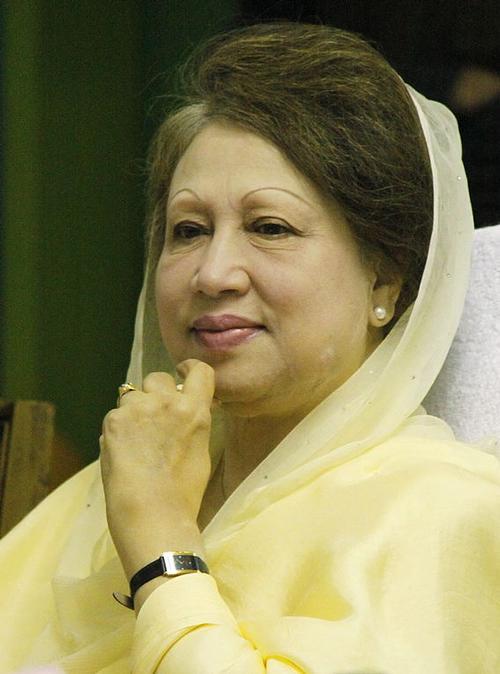
The parliamentary boycott of the four opposition parties also continued in 2000, despite the fact that the BNP's Akhtaruzzanab decided to lift the boycott. Relations between the United States and Japan continued to improve, in contrast to the relationship with Pakistan, which deteriorated more and more. For example, Pakistani military leader Musharraf refused to meet with Prime Minister Hasina Wajed.
In 2001, Hasina Wajed became the first Prime Minister to serve the full five-year term. In July, Latifur Rahman was appointed head of an interim government whose main task was to organize free elections as soon as possible. In addition, it was hoped that the interim government could ensure an end to political violence. But that was very disappointing: an attack on an office of the Awami League killed 16 people, followed by another period of violence.
The very violent elections of October 2001 were won by the BNP of Begum Khalida Zia. Hasina Wajed's ruling Awami League ended up in opposition because the BNP, together with the other opposition parties, was able to form a two-thirds majority. Khalida Zia became prime minister in October, as in 1991 and 1996. The opposition boycotted parliament again and organized several strikes in 2002.
On June 21, 2002, President Chowdhury resigned, preceded by the entire military summit. A few months later, Iajuddin Ahmed became the new president.
2003 was also marked by many strikes, often supported by the opposition Awami League. On August 21, 2004, an attack on a demonstration by Awami League supporters took place in Dhaka. Sheikh Hasina Wajed was also injured and a nationwide strike was immediately declared, which paralyzed all daily life. In response, the government ordered the arrest of opposition supporters. In September, the Supreme Court ordered the arrests to be stopped. On December 11, 2004, the Awami League organized a 900 km long chain consisting of millions of people. As a protest against insecurity, inflation and corruption in Bangladesh. In the years 2005 and 2006 there have been many bombings by Islamic militants. In October, violent protests against the government's decision to establish a business cabinet after Prime Minister Zia's term have been staged. President Ahmed tries to mediate and calls elections for January 22, 2007. These are then postponed and Fakhruddin Ahmed takes charge of a business cabinet. In November 2007 Banglagesh is hit by cyclone Sidr, thousands are killed and hundreds of thousands are in dire need. In December 2008, Sheik Hasina's Awami League won 250 of the 300 seats in parliament, in January 2009 Hasina was appointed prime minister. In November 2009, five former army officers were finally sentenced for their part in the murder of former Prime Minister Sheikh Mujibur Rahman. This ends a lengthy and controversial lawsuit in Bangladesh.
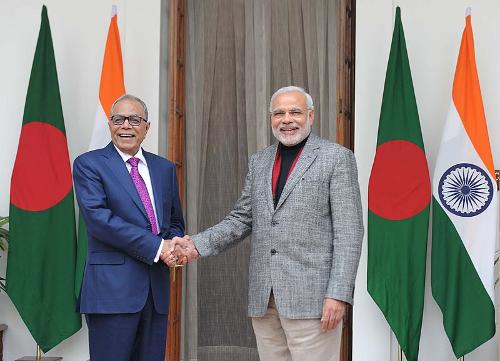 President Hamid of Bangladesh (left) meets with Modi of IndiaPhoto: Government of India Government Open Data License - India (GODL) no changes made
President Hamid of Bangladesh (left) meets with Modi of IndiaPhoto: Government of India Government Open Data License - India (GODL) no changes made
In April 2013 there are parliamentary elections Abdul Hamid becomes the new president. In the spring of 2013 there is a lot of commotion about fires and appalling conditions in the clothing industry. European buyers sign a covenant in the summer of 2013 to improve the working conditions of the workers. In January 2014, Sheik Hasina wins again and is given a third term as prime minister. In 2015 and 2016 there has been a lot of violence by Islamic activists against other groups. In January 2016, two people were sentenced to death for the murder of Atheist blogger Ahmed Rajib Haider. In 2016 and 2017, large groups of Rohingyas flee from neighboring Myanmar to Bangladesh, where they shake up in relief camps in harsh conditions. In December 2018, the Awami League convincingly wins the elections and President Hamid is given a second term.
The January 2024 parliamentary elections were won by 76-year-old Prime Minister Sheikh Hasina, who has been in power since 2009 and is the leader of the Awami Muslim League. She is preparing for a fifth term in office. The elections were boycotted by the Bangladesh Nationalist Party (BNP), the main opposition party. The election, contested for alleged corruption, was overshadowed by violence and turnout was estimated at only 40 per cent.
Sources
Beurden, J. van / Bangladesh : mensen, politiek, economie, cultuur, milieu
Koninklijk Instituut voor de Tropen
Brace, S. / Bangladesh
Thomson Learning
McAdam, M. / Bangladesh
Lonely Planet
Whyte, M. / Bangladesh
Marshall Cavendish
CIA - World Factbook
BBC - Country Profiles
Copyright: Team The World of Info